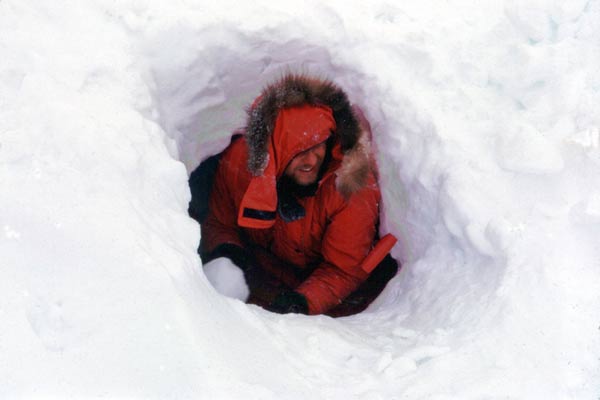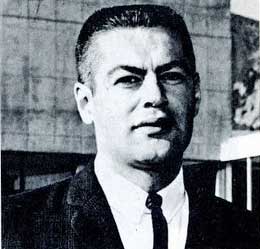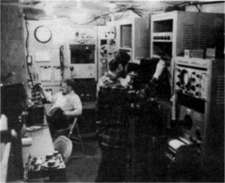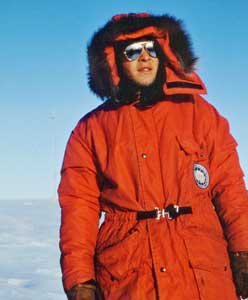
SCIENTIST MISSING FROM BYRD STATION PRESUMED DEAD
|
At 0915 on 8 May [1965], Disch departed the radio noise building, presumably returning to the main station complex, 7,000 feet south of the radio noise building. A handline runs from the meteorology building at the main station to the ladder at the base of the radio noise building. When, by 1000 hours, Disch had not arrived back at Byrd, a vehicle search party departed the station to search the area of the handline.
About 1130 his trail was picked up leading west of Byrd Station proper. It led to the southwest corner of the skiway, a distance of about 4 miles. At this point, the search party returned to the station to refuel. They returned to the field and spent 3 more hours trying to pick up the trail, but to no avail. Winds of 25 to 30 knots and drifting snow covered the tracks made by Disch and rapidly covered the tracks of the Nodwell, making the safe return of the search party very difficult. They returned to Byrd at 1815 hours. At 1900, another search party was sent to investigate the area of the supply line, emergency Jamesway, and dump. No tracks were found. At 1950 all able hands were mustered and made a human chain search from the dump area to the end of the skiway. Flares were fired every half-hour from the aurora tower and flood lights were rigged over the station. Visibility conditions eventually prevented the flares from being useful and they were discontinued. Another vehicle search party was launched at 1800 hours on 9 May. It covered a 1-mile-wide by 9-mile-long area running south of the skiway. The party found occasional tracks and followed them to about 4 miles south of the station where they disappeared. There was no noticeable shortening of stride in these tracks. An eight-man search party, equipped with two vehicles, a Jamesway, and sufficient fuel and provisions to last a week, departed the station on at 0740 on 10 May on a southerly track. It searched to about 12 miles south of the station, marking the trail with flags. No tracks were found, however. On 12 May, they searched the northeast and southeast sectors of old Byrd Station. The visibility was good but darkness severely limited their range of vision. The next 2 days visibility was so poor, due to blowing snow and fog, that no search was possible. Disch was fully clothed with the customary Antarctic clothing. The temperature during the search was about minus 44 degrees Fahrenheit. The tracks that were found indicated that he did not contact the handline, which started at the ladder of the radio noise building, but headed in a direction directly downwind. Due to the length of time Disch has been missing in the exposure of the Antarctic winter, he is presumed dead. Memorial services were held by his fellow men in Antarctica and by friends and relatives in his hometown. --from the Bulletin of the U. S. Antarctic Projects Officer (an official U. S. Navy publication), Vol. 6, No. 7, April 1965. TRAGEDY AT BYRD STATION
Throughout this period, there were intermittent storms with winds up to 45 knots and visibility reduced to zero by heavy blowing snow, seasonal darkness, and overcast. At one point the temperature dropped to -79°F, seriously interfering with the movement of men and vehicles. The station complement utilized the brief twilight at midday and the light of the full moon whenever possible to advance the search efforts. A memorial service for Carl Disch was held in his hometown of Monroe, Wisconsin on May 14, attended by Dr. T. O. Jones, Head of the Office of Polar Programs, and Mr. Stephen Barnes from the Central Radio Propagation Laboratory, National Bureau of Standards. Further search is planed for the return of daylight in the spring. --from the Antarctic Report, Office of Antarctic Programs, National Science Foundation, May, 1965. May 8, 1965: NIST radio researcher Carl Disch disappeared in blizzard-like conditions in Antarctica Tragedy in AntarcticaCarl Disch, who joined the Boulder Laboratories staff last year for duty with CRPL [Central Radio Propagation Laboratory] in the Antarctic, is missing from his post at the Ionosphere-Forward Scatter station near Byrd Station. Memorial services were held at his hometown, Monroe, Wisconsin, May 14 after a week of intense searching of the Byrd area by Navy and scientific personnel at the station. At the time of his disappearance on May 8, presumably as he was returning to the main station after a visit to the Radio Noise installation operated by Frank Recely for CRPL, the temperature was 45 degrees below zero (F), with 35-mile-per-hour winds kicking up the loose snow. In the dark and the blizzard, he apparently missed a handline that stretches the full 7,000 feet from Recely's station to Byrd. --from a #TBT tweeted by NIST on 7 May 2015. The black-and-white images depicted above are from the respective sources as indicated. The two color photos of Carl Disch are by Dale Blake, one of the two 1964 Byrd CRPL winterovers, and were taken during the project turnover during the 1964-65 summer. The photos came to me from Dale's son Byron Blake, who worked at Pole during the 2015-16 summer. One interesting anecdote must be added here, told to me by a good Pole friend--long before he ever set foot on the ice, he had a summer job working as a telescope operator at Kitt Peak National Observatory. One of his coworkers who also worked nights was...Frank Recely. A really nice guy, but one of the most boring people my friend had ever met (and keep in mind that things can get mighty boring at an astronomical observatory on nights when it is cloudy). After my friend had been there for a few months, another operator told him that Frank had spent some time in Antarctica some years before, and that he'd literally bored a coworker to death. The story was that the guy [Carl] got so tired of Frank's monotone that he just gave up and walked out onto the plateau, never to be seen again. Frank never mentioned the incident, or the ice at all, to my friend. Another anecdote told to the same friend by the late Stanford VLF researcher John Katsufrakis, whom I also knew--John said that supposedly the incident that triggered his disappearance was a card game during winter. Disch accused someone of not treating him correctly or even cheating, threw his cards down and announced that he was going to visit his friends "at pole". No one thought twice about his tantrum because he had done similar things before, but that was the last anyone saw of him. |
 Carl Robert Disch, a National Bureau of Standards scientist wintering-over at Byrd Station, customarily travelled between the main station complex and the radio noise building performing his scientific studies. He had travelled the route over 25 times so far this season.
Carl Robert Disch, a National Bureau of Standards scientist wintering-over at Byrd Station, customarily travelled between the main station complex and the radio noise building performing his scientific studies. He had travelled the route over 25 times so far this season.
